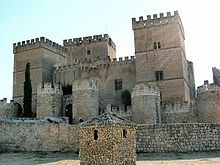Diego de Sandoval y Rojas, 9th Count of Saldaña
[9] In 1605, Diego de Sandoval was confined to his father's castle at Ampudia for having been involved in a brawl in Valladolid,[1] and nearly died from a sword wound to the chest.
[4] Some years later, in 1612, he was involved in another incident which resulted in him being confined to the Ducal Palace of Lerma, punishment which was lifted thanks to the intervention of Henry of Lorraine, Duke of Mayenne, the French ambassador.
[4] Their son, Rodrigo, the future 7th Duke of the Infantado (through his grandmother, who outlived his mother), was born in 1614;[1] King Philip III and the Infanta María were his godparents.
[11] Lope de Vega, in a letter to the Duke of Sessa, dated September 1617, described the count as "the living image of his father, discreet, kind, polite, friendly and worthy of especial consideration in this age".
[4] In April 1621, Saldaña suffered the consequences of court intrigues when the new favourite Count-Duke Olivares persuaded the young King Philip IV to strip the Count of his court privileges, including his Commandery of the Order of Calatrava, for having an affair with Mariana de Córdoba, a lady-in-waiting to the Infanta María.
[9] Although the title of Saldaña later passed to Diego de Sandoval's eldest son Rodrigo, as heir to his grandmother, the Duchess of the Infantado, Diego de Sandoval continued using it until his death, while his son Rodrigo used the title Count of Cid.
[4] The National Palace of Sintra in Portugal has a full-length court portrait of Saldaña at the age of eighteen, from the Spanish school, attributed to Juan Pantoja de la Cruz who, in 1602, had painted a full-length portrait of Saldaña's father, the 1st Duke of Lerma.
